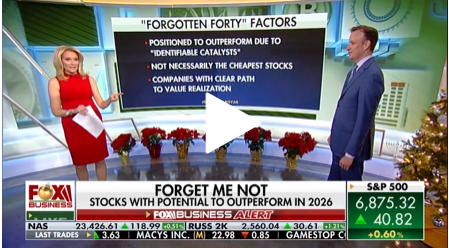Boyar’s Thoughts on What to Expect for the 2nd Half of 2023
Jonathan Boyar joined Yahoo Finance Live to discuss what to expect as we move into the second half of the year after a resilient market throughout the first half of 2023.
Among the topics discussed:
- What is driving the current stock market volatility
- Why small cap stocks are attractive
- How consumer trends are influencing the stock market
- The merits of investing in publicly traded sports franchises
.@boyarvalue’s Jonathan Boyar believes AI, the Fed, and FOMO are responsible for the volatility that we’re seeing in markets. Find out why below: pic.twitter.com/k6ZlIVEWdZ
— Yahoo Finance (@YahooFinance) June 27, 2023
Anna Han:When we looked at low volatility strategies coming into this year, it was still when we’re pretty uncertain on how this hard landing or soft landing scenario was going to come out. And there’s still a lot of fear in the market. So you saw that risk aversion was the one of our quant factors that continued to outperform for, uh, February or February to April. And now it’s been interesting as investors have had this sudden mentality shift of maybe we can achieve that soft landing. Maybe the Fed won’t go too crazy or over tighten. And that kind of hope has helped bring a little more bid to risk. Something we talked about with that small cap rotation. But what’s also suppressed, a lot of the equity ball here has been that in inspiration has been that, uh, hope. And it’s also been that the market has been grinding higher led by just a few names.(00:48)That grinding higher has brought a lot of implied volatility in the front end of the volatility term structure lower, it’s also made skew a lot flatter skew. When we talk about in the front is thinking about how much are investors buying downside protection versus upside uh, exposure. And there’s not that much exposure to the downside. So if people aren’t buying that much per protection, it makes it cheap to buy that downside protection and becomes more perhaps, valuation worthy of looking into it. In particular, if you think that there could be a little bit of a pullback, maybe as these AI names lose a little steam, maybe as we see that rotation into small caps, and also as we get to month end, you might see some money come out of equities. So these are all the things we think about when we look at the ball markets and try to assess whether volatility is cheap enough to look for those hedges.Yahoo Finance (01:39):
Yeah. Jonathan Anna through the alley. So I’m gonna try and complete the oop here. When it comes down to who is responsible, what part of this kind of broader calculus is responsible for the volatility that we’re seeing is, is it solely the Fed or is it also just the overhype in AI as she was mentioning a moment ago?Jonathan Boyar (01:56):
I I think it’s both. Uh, I mean, I think there’s a, there’s a mania or it’s not quite a mania, but up there with a mania on a AI, obviously everyone’s never to the Fed, and then there’s fomo. You’re seeing now people are putting money into the market after, uh, after the market’s up 13, 14% and, uh, as measured by the s and p. So you have a lot of reasons why the stock market could grind higher, but you know, the question is, will the, will the first half leaders be the second half leaders? I don’t think so. Um, but you know, I, I think, you know, small cap will, will lead either in the second half or the beginning of next year, and that’s where investors should be positioning themselves.Yahoo Finance (02:38):
Do you think that AI kind of rug pull, if you will, happens in the second half of this year?Jonathan Boyar (02:42):
You never know. I mean, you, you look back at 19 98, 19 99, that lasted a lot longer than anyone ever would’ve expected. Microsoft sold for 50, 60 times earnings. Uh, Cisco service was, you know, had a, had a three digit earnings multiple. Is it, the question is, and I’m not saying it is, is Nvidia, Cisco of, uh, of, uh, of, of today and may, maybe it is, you know, they got the concept right, but the valuation was just way too expensive.Yahoo Finance (03:07):
Um, sort of on a related note and sort of looming all over this overall of this and all over the volatility discussion is what could go wrong mm-hmm. In this scenario. Right. And Anna, I wanna put that question to you because I think of summer at in particular, as a time when things go wrong, right? People are out at the beach, the volume is low, there are shocks in the system that kind of tend to happen in the summer. What, what would be your nominees for shocks this summer?Anna Han (03:36):
No, you’re absolutely right. Liquidity in the summer can slow down and that can lead to some surprise moves. It can lead to some gapping, especially when everyone’s trying to take that summer beach vacation. So something we’ve been looking at has been quoted as we have looked at the issue of what happens if these student loans, uh, get knocked down and the Supreme Court. And if we do see student loans have to start again now on a broad basis, we don’t think it breaks the back of the consumer, but it certainly could cause a lot of pain for some of the households that have been a little more debt heavy. And in particular one part that you look in, the economic data that you see on a loan delinquencies have been rising for a bit of a younger population, the under 30, under 40 group. And that’s also a group that had, tends to hold most of the student loans.(04:23)
So you see that kind of combined. There could be, uh, some pain points there and that could actually, uh, have an impact on equities. But broadly speaking, so far we think the risks here, the people are under hedged. And so when you see a pullback in the markets when people are under hedge, it’s a surprise. There’s a bit of a scramble to try to get that protection or try to de-risk. Now these are the kind of things that can feed upon themselves in a low liquidity market, but now these are very much tail risks and so far we still believe that the market could really be trending sideways for a while, uh, and prefer to look for that opportunity that’s more valuation attractive in that small cap spaceYahoo Finance (05:03):
In a sideways trending market. Where, where are those opportunities on, on the valuation front?Jonathan Boyar (05:08):
Uh, on, well, I think stocks that have catalyst, you know, you have to go on a stock specific nature. I, I had mentioned Liberty raves, for example. Uh, they’re about to spin out, um, do a hard spin. It’s a, it’s a tracking stock, it’s gonna be an asset backed stock. It’s gonna happen in the next couple of weeks that could propel the stock higher. You have stocks like Howard Hughes Corporation, which Bill Ackman, you know, the, the hedge fund, um, you know, in investor is chairman, uh, owns 33% of it keeps buying it every day. So there’s kind of an Ackman put, if you will, in, in the stock. So you have to, if you do your research, you do your homework and you know your names, these type of things shouldn’t matter. Um, and you know, I think investors should stop trying. There’s always a reason not to buy stocks. And if you told me at the beginning of or told an investor at the, of the year, you’re gonna have a banking crisis and a debt ceiling showdown, uh, would you want to be in the market? Probably not. And look what you would’ve missed. So I think you need, investors should stop really focusing on what could go wrong and look at company by company, and you want to own these things.
“This is a classic example of why you have to stay fully invested,” @boyarvalue’s Jonathan Boyar says on the resilience that we’ve seen in the market so far. “You never know when the market will go up, won’t go down.” pic.twitter.com/7aWxhpZ0a3
— Yahoo Finance (@YahooFinance) June 27, 2023
Click Here to Read the Interview Transcript
Jonathan Boyar (00:00):
That’s a great question. And you know, I guess you have to take a step back in the beginning of the year, no one would’ve ever predicted that the s and p would be where it is now, as well as the Q Q Q. So it, it’s pretty hard to, to make these types of predictions. But the one thing I would say is this is a classic example of why you have to stay fully invested because you never know when, um, the market will go up, won’t go down. It’s better to take kind of a long term approach. But if history is any guide, if you have a fir a strong first, uh, half of the year, the second half of the year is also strong. That’s, you know, going back to data from, from 1945, and this really shouldn’t be much of a surprise either. If you look back, uh, historically, the third year of a presidential cycle is typically quite strong. Uh, no strategist going into the year would’ve expected this, but if you look back at history, it’s, it shouldn’t have been unexpected.
Yahoo Finance (00:53):
But I guess the, the anomaly here is that we have never had a fed that’s been in a rate cycle pattern, uh, or or rate hiking pattern at this point in the cycle, like we’ve seen right now. And, and Anna, I guess from your perspective as well, does that mean even if the s and p 500, because to Jonathan’s point we’ve seen that move higher by about 13% year to date, does that mean that the, the rally is still on into the second half?
Anna Han (01:17):
It’s possible that the rally still has some legs, and you bring up a great point, uh, Jonathan, that we know it’s fed path driven here, but something we keep in mind is what is really leading this market? Where’s the concentration and the lack of breath is something we’ve had a lot of conversations on. So even if you say to be exposed to the market, really it becomes what part of the market are we, is do we want in our portfolios? And also how much more can this AI driven fever go? You look at really it’s been the top 10 names, maybe even eight names in the S&P 500 that has led this rally. Even if the Fed decides to go another 25 basis points, which is what we expect in July, perhaps even 50 basis points is on the table for the rest of this year, it’s very possible that that’s not enough to really cool the market unless we really see something break the consumer. And so far we’re not seeing big signs of that in the data.
Yahoo Finance (02:10):
So putting all that together, Anna, it sounds like you think that we could still see stocks continue to move higher from here?
Anna Han (02:18):
I think it’s possible. At the same time, something that we have noticed is because people are expecting the Fed to cut, though we don’t think that it’s gonna happen that quickly. The expectation of yields probably coming lower in those fed cuts have helped bring out a little bit of risk appetite. Now, risk appetite has been expressed also and a little bit of a rotation that we’ve seen into more small cap space. So if we see that rotation, uh, gain some momentum, we might see large cap stall out, move sideways, we might see a little bit more life breathe into the small cap, mid-cap space. So that’s one possibility and that’s what we’re looking
Jonathan Boyar (02:54):
For. Do you also think 50 basis points through the end of this year, bips? Uh, I just love using the bips sometimes. <laugh>.
Jonathan Boyar (03:00):
Yeah, it’s a nice word to use. I, um, I would, I I really can’t comment on that. Who knows what the Fed is gonna do, what they say and what they do has been very different if you look back over the last year or two. But to Anna’s point, I think the best area to be in is in small caps right now. It’s by far the cheapest area of the market. If you look back over the past five years, the Russell 2000 has basically done nothing, which is, uh, and it’s underperformed larger caps by about 7% per year. You look at the S&P 500 equal weight, which you know, has more of the smaller names in there. It’s down, it’s up only about 4% per this year. So that’s the area where there’s opportunity as opposed to these large cap names that for the most part are pretty overextended.
Yahoo Finance (03:44):
Well, opportunity is all well and good, but something has to change in order for, you know, in other words, that underperformance could continue in unless something changes. What would change to catalyze those small caps? For example, Jonathan?
Jonathan Boyar (03:56):
Well, it’s valuation, but as to your point, valuations have been cheap for a long time.
Yahoo Finance (04:00):
Valuation alone isn’t usually a catalyst, right?
Jonathan Boyar (04:04):
Yes. It, it’s hard to tell what the, what the catalyst will be. No one would’ve thought there would’ve been a banking crisis in March. So it’s hard to tell. So if you, if the best predictor prediction of future returns is valuation, so if you can just stand the pain and not have the instant triangle for instant gratification, I think people over the next five years will be very happy that they invest in kind of smaller cap names. And I think it’s, it pays to be selective because, uh, especially in those areas, not all names are created equal.
Yahoo Finance (04:31):
And Anna Small caps right now or do you remain defensive? Where are you kind of overweight or saying that there should be the most focus in an investor’s portfolio right now?
Anna Han (04:42):
Well, we haven’t actually been that defensive in our portfolio, at least not in the traditional sense. We came in the year long media and entertainment and while we did ask investors to trim the volatility in their portfolios and be conscious of having some low exposure or at least avoiding high volume exposure, we weren’t looking to be in the youths or REITs or Staples space. Um, and something that Jonathan mentioned is you have to be selective down the cap. We know it’s a riskier play, but something that might change as well in addition to valuations and traditional fundamentals. Look at the technical of how much the Uber caps or you can use as a proxy. The Russell top 50 have outperformed the basic broader market or the S&P 500. When you look at how that’s done over a five, six year basis, you’ve seen that it’s hitting, it’s technically over bot levels. And that is also another signal to add on to Jonathan’s point about valuation, why maybe it’s time that small caps can have its, uh, chance in the sun here, or at least that we see a little bit of losing steam in this fever of these very concentrated biggest names leading the market.
“The consumer is becoming more price conscious,” Wells Fargo Securities Equity Strategist Anna Han says on the expectations for the next quarter of earnings. “That’s been a trend we’ve been seeing and we think it’s going to continue.” pic.twitter.com/NUyFVV6XQj
— Yahoo Finance (@YahooFinance) June 27, 2023
Click Here to Read the Interview Transcript
Anna Han (00:00):
We’ll say it’s still early in the season, but something that I think they specifically mentioned is that the consumer’s becoming more price conscious. That’s been a trend we’ve been seeing, and we think it’s going to continue. And what we’ve seen with top line margins, uh, or excuse me, top line, uh, sales has been that it’s been declining on a quarterly basis at a much more rapid rate than I think a lot of the consensus on the street is expecting. So if that continues, you can imagine how much is already declining on the top line. We continue to see margin compression, so that bottom line earnings number that corporates are able to take home, it’s been shrinking faster than a lot of the consensus has projected for this year. So it makes us bring back to our conversation that Jonathan and I were having earlier about valuation. How can this market continue to trade on such a fat multiple when you’re seeing that the actual e p s value that should be driving the market is shrinking faster? So our outlook really is that we’re cautious on earnings. We do think that the earnings decline, or perhaps I would say quote on quote earnings recession comes before we see that G D P recession.
Yahoo Finance (01:08):
Well, I mean, the stuff that’s trading on a fat multiple, the earnings look a lot better by, I mean, I’m generalizing, right? But I mean, something like Walgreens doesn’t have a fat multiple, right? It’s, it’s pretty cheap. And, and I guess you could say maybe justifiably so. So I, I guess in this market, Jonathan, how do you find something that is actually growing but is cheap <laugh>
Jonathan Boyar (01:30):
That, you know, that’s the billion dollar question? Yeah. I mean that’s one of the reasons, to your point about insurance, companies is why we prefer CVS over Walgreens. Visa has that, that kind of anchor, although they’ve had some unforced errors over the past year, but you know, you’re now buying a stock at eight or nine times earnings that has a nice dividend yield that’s de-levering. So there’s a lot, there’s a lot to like on the story. But it is interesting, their comments. I wouldn’t extrapolate it to everyone that the consumer is trading down or is being more budget conscious, but you, you just want to buy and look for good companies that have good value that people want to spend money to. Like a company like let’s say Topgolf Calloway Brands, which we, we talked about last time I was on the show,.
Yahoo Finance (02:17):
He wants to spend some money there. I know that.
Yahoo Finance (02:20):
It’s a great experience, top notch, top.
Jonathan Boyar (02:22):
Notch golf, and it’s also a cheap stock. And, you know, I was there this weekend. You, you spend, it’s a great business. It’s growing. Same store. Sales are up about 11% per year. The stock is trading like a golf equipment maker instead of a fast growing entertainment concept. So you just have to pick your spots and you don’t have to buy everything. And you know, sometimes you get what you pay for. You have to be very careful. I wouldn’t wanna have a portfolio just consisting of eight times earning stocks because you’re gonna get a lot of broken stores.
Yahoo Finance (02:54):
Do you see any recess or at least receding in the among consumers that we’ve been hearing about over the course of last earning season?
Jonathan Boyar (03:04):
We’ve been hearing this for, for quarters, and you know, right now you still have a very good employment picture. People are spending money, they’re spending money on different things. They’re spending money on experiences, you know, companies like Liberty Braves that we like in Atlanta, Braves baseball team. People are still going to the ballpark, especially because they, unlike the Mets are doing well,
Yahoo Finance (03:26):
On this front also, you know, it’s interesting you talked about your, you guys like TMT stocks, uh, telecom, um, and media here. Um, is that something you continue to like, that’s sort of the other side of this coin, right? People staying in and streaming maybe instead of going out and and spending on various events?
Anna Han (03:46):
Well, I think there’s a mix that you see in that TMT space specifically for us, why we prefer the media entertainment. So we think the valuations there, even though it’s had a great performance here to date, almost keeping up with the Q Q Q, is that the valuations are still a little more reasonable than you see on some of the other parts of the tech sector. And it has this combination of, there are these experiences parts, it’s not necessarily only tied to staying in, but it’s mostly experiences versus having these durable or hard goods. At the same time, you’re getting this combination of, you get that AI flavor in there. There’s a lot of this, uh, exciting new, uh, technology machine learning that these kind of companies are using. So a way to get exposure to that rather than chasing what you might have feel like a train that’s already left the station is to look into that media and entertainment space.
Anna Han (04:34)
But I think the broad theme that we need to keep in mind here is what is the consumer trend? Uh, even as you go or expect a recession, or even if you expect some of other parts of the consumer to remain perfectly healthy and continue to spend as they have, then you need to think about what has changed post pandemic and what’s the consumer spending gonna look like for the next 1, 2, 3 years. And that’s gonna really help guide the kind of sectors that you want exposure to and find what is cheaply valued but not cheap for a reason.
Important Disclosures. The information herein is provided by Boyar’s Intrinsic Value Research LLC (“Boyar Research”) and: (a) is for general, informational purposes only; (b) is not tailored to the specific investment needs of any specific person or entity; and (c) should not be construed as investment advice. Boyar Research does not offer investment advisory services and is not an investment adviser registered with the U.S. Securities and Exchange Commission (“SEC”) or any other regulatory body. Any opinions expressed herein represent current opinions of Boyar Research only, and no representation is made with respect to the accuracy, completeness or timeliness of the information herein. Boyar Research assumes no obligation to update or revise such information. In addition, certain information herein has been provided by and/or is based on third party sources, and, although Boyar Research believes this information to be reliable, Boyar Research has not independently verified such information and is not responsible for third-party errors. You should not assume that any investment discussed herein will be profitable or that any investment decisions in the future will be profitable. Investing in securities involves risk, including the possible loss of principal.









